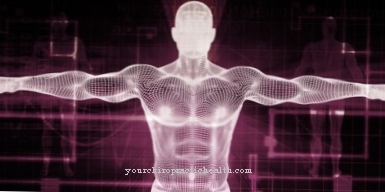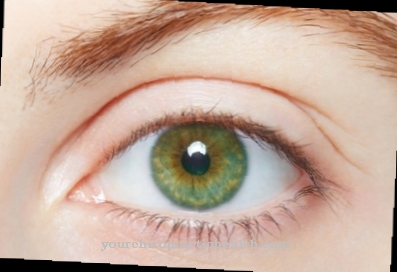The Chain of perception is a six-part model for a better understanding of the perception process. Your six limbs influence each other and connect again in a permanent cycle. A disturbed chain of perception is associated with phenomena such as hallucinations.
What is the chain of perception?

Sensory technology deals with human sensory perception. The human organism is equipped with various sensory structures for processing information and gaining information from the environment. All sensory structures make use of environmental stimuli that are absorbed into the organism in the form of bioelectrical excitation. In the body, the partial information is filtered from the individual sensory structures and combined into meaningful overall information. The partial information together form the perception.
The chain of perception is the basic model of the concept of perception. It has six different links that are mutually influencing. In this model, the perceptual apparatus faces the outside world. The chain of perception is self-contained and can be described as a cycle.
This cycle is involved in every type of perception in the same order. The six links in the chain are stimulus, transduction, processing, perception, recognition and action.
Function & task
Life is perceiving. This means that perceptions are vital for every organism. Every action is a response to sensory information. Perceptions help people to orientate themselves and assess the environment. Thanks to the perception apparatus, humans can adjust their actions to the environment. Without the perceptual apparatus, humans would be separated from the outside world and could no longer act meaningfully.
At the beginning of the chain of perception is the stimulus. The objects in the environment generate signals that correspond to physically measurable quantities. These signals give people a picture of their environment and allow them to assess their relationship to the out-of-body.
For this purpose, the stimuli hit the sensory cells of the respective sensory system. The sensory cells are excited by the external stimuli and convert various forms of energy into bioelectrical or biochemical voltage changes in a transduction process. This is how action potentials arise.
The preprocessing of the received signals usually takes place in the receptors themselves. However, the actual processing of the information is done by the brain. Processes of filtering, inhibition, convergence and divergence as well as integration and summation serve to obtain overall information in the individual brain regions. This total information passes through cognition into human consciousness. Sound becomes sound here. Electromagnetic waves turn into light. Only the conscious total information leads to an understanding or assignment of the information.
Through processes such as remembering, combining, recognizing, associating or judging, the human brain assesses the importance of conscious perception. The end result of a perception is the reaction. This reaction usually corresponds to an adapted action. Often only the action makes additional perceptual information accessible to the person.
For example, if a link in the chain of perception is disturbed, then the response to this disturbed perception can correspond to an elimination of the disturbance. Thanks to cognition, humans are aware of the connection between individual stimuli and their representation in the central nervous system. For this reason he recognizes when he is missing a link in the correct sequence of the chain of perception. For this reason, he can recognize, identify and consciously eliminate faults. In order to collect additional information about a situation, the reaction can be, for example, a palpation or a movement of the eyeball.
The chain of perception is permanently connected to itself. The immediacy and speed of the individual steps takes only a fraction of a second.
You can find your medication here
➔ Medicines for eye infectionsIllnesses & ailments
The chain of perception plays a role both in general medicine and in psychology. Receptor defects in the sensory structures can, for example, disrupt the chain of perception and deprive the person concerned of their adapted ability to react. The same applies to brain lesions in the areas that are responsible for processing and dividing perception.
Both receptor defects and brain lesions are physiological causes of perceptual illusions or other disorders in the perception chain. On the other hand, mental illnesses without a physical cause can also lead to false perceptions, illusions or hallucinations.
With illusions, real facts are perceived differently. This phenomenon shapes many clinical pictures in the field of psychology and is known, for example, from phenomena such as the spotlight effect. Those affected believe that they are constantly being observed and judged by the environment. People with social phobia particularly suffer from this illusion.
With hallucinations, patients perceive things that are not actually there. Without the corresponding environmental stimuli, there can be perceptions of one or all of the sensory areas. The cause can be psychosis or sleep deprivation. Physiological changes in the brain also sometimes trigger hallucinations. Hallucinations as a result of brain changes in the context of epilepsy were observed particularly frequently.
Perceptual illusions do not necessarily have to be a pathological phenomenon. In this way, optical illusions in particular can be achieved through certain color combinations without any actual change or disruption in the chain of perception. The line between deception and reality is difficult to see, especially for the eyes. They work with two-dimensional images and still give people the feeling of perceiving the environment in three dimensions.

























.jpg)

.jpg)
